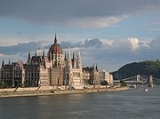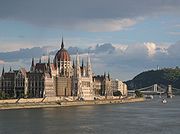
Imre Steindl
Encyclopedia
Imre Steindl was a Hungarian architect.
and the Academy of Fine Arts Vienna
. He was a teacher of the Budapest Technical University from 1869. He was elected honorary and corresponding member of the Royal Institute of British Architects
in 1891 and was admitted to the Hungarian Academy of Sciences
in 1898.
 His architectural interest was initially historicism
His architectural interest was initially historicism
, then Renaissance
and Gothic style.
He is most famous for the Hungarian Parliament Building
built in Neo-gothic style
, but his other outstanding works include the Saint Elisabeth
Church as well as the reconstruction of the St. Elisabeth Church and the Vajdahunyad Castle
.
Steindl went blind before the completion of the Hungarian Parliament and died in 1902 in Budapest
. He is buried at Kerepesi Cemetery
.
Biography
He graduated at the Technical University of BudapestBudapest University of Technology and Economics
The Budapest University of Technology and Economics , in hungarian abbreviated as BME, English official abbreviation BUTE, is the most significant University of Technology in Hungary and is also one of the oldest Institutes of Technology in the world, having been founded in 1782.-History:BME is...
and the Academy of Fine Arts Vienna
Academy of Fine Arts Vienna
The Academy of Fine Arts Vienna is an institution of higher education in Vienna, Austria.- History :The Academy of Fine Arts Vienna was founded in 1692 as a private academy by the court-painter Peter Strudl, who became the Praefectus Academiae Nostrae. In 1701 he was ennobled as Baron of the Empire...
. He was a teacher of the Budapest Technical University from 1869. He was elected honorary and corresponding member of the Royal Institute of British Architects
Royal Institute of British Architects
The Royal Institute of British Architects is a professional body for architects primarily in the United Kingdom, but also internationally.-History:...
in 1891 and was admitted to the Hungarian Academy of Sciences
Hungarian Academy of Sciences
The Hungarian Academy of Sciences is the most important and prestigious learned society of Hungary. Its seat is at the bank of the Danube in Budapest.-History:...
in 1898.

Historicism (art)
Historicism refers to artistic styles that draw their inspiration from copying historic styles or artisans. After neo-classicism, which could itself be considered a historicist movement, the 19th century saw a new historicist phase marked by a return to a more ancient classicism, in particular in...
, then Renaissance
Renaissance
The Renaissance was a cultural movement that spanned roughly the 14th to the 17th century, beginning in Italy in the Late Middle Ages and later spreading to the rest of Europe. The term is also used more loosely to refer to the historical era, but since the changes of the Renaissance were not...
and Gothic style.
He is most famous for the Hungarian Parliament Building
Hungarian Parliament Building
The Hungarian Parliament Building is the seat of the National Assembly of Hungary, one of Europe's oldest legislative buildings, a notable landmark of Hungary and a popular tourist destination of Budapest. It lies in Lajos Kossuth Square, on the bank of the Danube, in Budapest...
built in Neo-gothic style
Gothic Revival architecture
The Gothic Revival is an architectural movement that began in the 1740s in England...
, but his other outstanding works include the Saint Elisabeth
Elisabeth of Hungary
Elizabeth of Hungary, T.O.S.F., was a princess of the Kingdom of Hungary, Countess of Thuringia, Germany and a greatly-venerated Catholic saint. Elizabeth was married at the age of 14, and widowed at 20. She then became one of the first members of the newly-founded Third Order of St. Francis,...
Church as well as the reconstruction of the St. Elisabeth Church and the Vajdahunyad Castle
Vajdahunyad Castle
Vajdahunyad Castle, or Vajdahunyad-vár, is a castle in City Park, Budapest, Hungary, that was built between 1896 and 1908, designed by Ignác Alpár...
.
Steindl went blind before the completion of the Hungarian Parliament and died in 1902 in Budapest
Budapest
Budapest is the capital of Hungary. As the largest city of Hungary, it is the country's principal political, cultural, commercial, industrial, and transportation centre. In 2011, Budapest had 1,733,685 inhabitants, down from its 1989 peak of 2,113,645 due to suburbanization. The Budapest Commuter...
. He is buried at Kerepesi Cemetery
Kerepesi Cemetery
Kerepesi Cemetery is the most famous cemetery in Budapest...
.
Main works
- New Town hall, Budapest (1870 – 1872, Budapest V., Váci u. 62 – 64.),
- Commercial Trade and Industrial Bank (1872)
- Vajdahunyad castle rebuilding (1870 – 1874) - carried out after the original designer, Ferenc Schulcz's, death
- SzegedSzeged' is the third largest city of Hungary, the largest city and regional centre of the Southern Great Plain and the county town of Csongrád county. The University of Szeged is one of the most distinguished universities in Hungary....
, Franciscan church remodelling (1876) - KassaKošiceKošice is a city in eastern Slovakia. It is situated on the river Hornád at the eastern reaches of the Slovak Ore Mountains, near the border with Hungary...
, St Elizabeth Episcopal House remodelling - University Buildings on Múzeum körút, District VIII (1880-1883)
- Máriafalva (today MariasdorfMariasdorfMariasdorf is a town in the district of Oberwart in Burgenland in Austria....
, BurgenlandBurgenlandBurgenland is the easternmost and least populous state or Land of Austria. It consists of two Statutarstädte and seven districts with in total 171 municipalities. It is 166 km long from north to south but much narrower from west to east...
, AustriaAustriaAustria , officially the Republic of Austria , is a landlocked country of roughly 8.4 million people in Central Europe. It is bordered by the Czech Republic and Germany to the north, Slovakia and Hungary to the east, Slovenia and Italy to the south, and Switzerland and Liechtenstein to the...
), St Mary of Resurrection reconstruction in Neo-Gothic style (1882-1899) with ZsolnayZsolnayZsolnay, or formally Zsolnay Porcelánmanufaktúra Zrt is a Hungarian manufacturer of porcelain, pottery, ceramics, tiles, and stoneware...
tiled main altar - St Elizabeth Church, Rózsák tere, Budapest District VII, (1893–1901)

